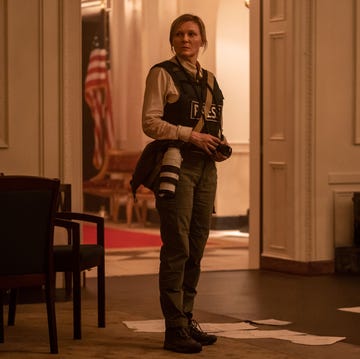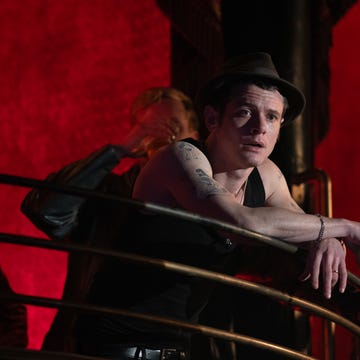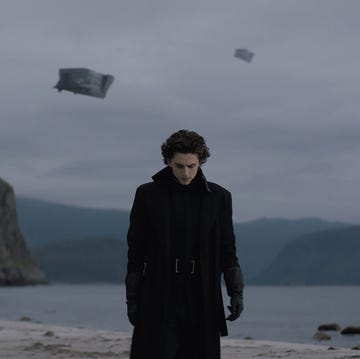10Pacific Rim
 Bear Grylls//Digital Spy
Bear Grylls//Digital SpyPacific Rim is a competently made, thoroughly enjoyable take on the classic monster movie and the “mecha” genre of Japanese anime (read: cartoons about giant robots battling each other). And as pure vehicles for computer-mapped spectacle go, it has a lot to recommend. But it also has little reason for existing other than capitalising on global box-office dollars. Its commitment to a multicultural cast is admirable (and now seems ahead of its time), but the sheer amount of technical-sounding exposition is mind-numbing, and sadly, it’s not quite stupid or campy enough to be funny.
9Mimic
 Bear Grylls//Digital Spy
Bear Grylls//Digital SpyDel Toro’s schlockiest work follows an arthropod-adoring scientist (Mira Sorvino) who creates a new breed of insect to kill a cockroach-spread disease. But the lab-designed species rapidly evolves into a bug-humanoid monster that threatens to kill, well, everyone. Somewhere between The Fly and Joe’s Apartment, the movie doesn’t even seem to take itself seriously, despite Sorvino trying her damnedest. The most notable thing about it is the stunning creature design. The effects may not live up to today’s standards, but with ethnic side characters who basically offer themselves up as sacrificial lambs for the white protagonists, the cultural standards are even more dated. (Warning: Do not watch this while eating. Really.)
8Hellboy
 Bear Grylls//Digital Spy
Bear Grylls//Digital SpyDel Toro was uniquely suited to take the reins of this superhero franchise, about an adorable demon baby born out of World War II who years later fights for the good guys. The director adds lightness to the darkness, injecting much-needed humour into a frequently self-serious genre. Longtime collaborator Ron Perlman looks like an over-the-hill WWE wrestler with two sausages stuck in his forehead as Hellboy. He’s the definition of a lovable prick, and while the script leans too heavily on typical origin-story plotting, the action choreography is top-notch.
Advertisement - Continue Reading Below
7The Shape of Water
 Bear Grylls//Digital Spy
Bear Grylls//Digital SpyThe Shape of Water is best understood as the most elaborately staged, visually stunning fairy tale of all time. Every surface of the Cold War-era Baltimore setting is meticulously designed and colour-coded. Sally Hawkins emotes like a silent-film queen as Elisa, a mute who cleans a secret government facility at night and happens upon its most important new asset, an amphibian-man who can communicate with humans. In him, she finds her unlikely romantic match. But as fairy tales go, it’s less subtle than many Disney classics, which is saying something. It strains to speak on behalf of the oppressed with thudding obviousness; it's supporting characters end up as little more than doe-eyed symbols bettering the cause of humanity. Del Toro, who has been so adept at juggling different moods and emotions in the past, fails to convey the messiness of his own premise. Even the woman-on-fish sex scene is ridiculously tasteful.
6Crimson Peak
 Bear Grylls//Digital Spy
Bear Grylls//Digital SpyBefore The Shape of Water, del Toro staged a fantastical romance with less prestige—but more guts—in Crimson Peak. The gothic horror film set in the late 19th century follows a young author (Mia Wasikowska) who marries Tom Hiddleston’s sweet-talker and soon finds herself living in a run-down, middle-of-nowhere mansion with him and his scary-clingy sister (Jessica Chastain). The movie’s genius lies in the way it subverts haunted-house gags for something altogether more lurid, sinister, and surprising.
5Cronos
 Bear Grylls//Digital Spy
Bear Grylls//Digital SpyDel toro deservedly broke out for his first feature, Cronos, a Mexican sci-fi/horror mashup that’s one part David Cronenberg and one part Bram Stoker. An antique salesman (Federico Luppi) discovers a clock that can give him eternal life, and in doing so causes havoc all around him. The director established his ability to lure in the viewer with unforgettable images, especially that of a man licking blood off a bathroom floor.
Advertisement - Continue Reading Below
4Hellboy II: The Golden Army
 Bear Grylls//Digital Spy
Bear Grylls//Digital SpyThe Hellboy sequel outdoes the original by dispensing with lame backstory and getting right to the juicy fight between the crazy-looking bad guys and the even crazier-looking good guys (including a perfect Doug Jones, also the “asset” in The Shape of Water, as a similarly fish-inspired hybrid). Del Toro indulges his love of monsters and steampunk design, but with his team of misfits he also makes an important point: Heroism isn’t about how you look or what you say or even how well you brood, but about what you believe and whose ass you’re willing to kick for it.
3Pan's Labyrinth
 Bear Grylls//Digital Spy
Bear Grylls//Digital SpyA sort of unofficial sequel to del Toro’s earlier The Devil’s Backbone, Pan’s Labyrinth became an unlikely cult hit for its handcrafted, impossibly majestic effects. A young girl (Ivana Baquero) who’s gone to live with her militant, Franco-supporting stepfather in post-Civil War Spain realises the inhumanity around her as she also discovers a portal to another world. The movie finds del Toro moving closer to fairy tales and away from reality, and while its two realms never entirely mesh, each is moving and impossible to look away from.
2Blade II
 Bear Grylls//Digital Spy
Bear Grylls//Digital SpyTechnically speaking, the great black superhero movie has already been made before Black Panther is out in cinemas. Del Toro’s most successful franchise outing is still the Blade sequel, about the Marvel half-vampire (Wesley Snipes) born in a whorehouse who’s determined to slaughter vampires in order to avenge his family by any means necessary. Hinging on a virus infecting the vampire community that threatens to decimate everyone, the plot is one Rent reference away from being an on-the-nose AIDS parable. The whole things unfolds in murky shadows, hedonistic raves, and bloodthirsty stares. It’s an apocalyptic party for the ages.
Advertisement - Continue Reading Below
1The Devil's Backbone
 Bear Grylls//Digital Spy
Bear Grylls//Digital SpyDel Toro’s best movie also feels like his most personal (he dedicated it to “mis padres”). Like Pan’s Labyrinth, the Spanish-language The Devil’s Backbone literally connects a supernatural tale to the Spanish Civil War. But unlike Pan’s, it does not flinch at the horrors of war and Franco’s rule—nor does it let its kid protagonists and audience escape into a comfortable fantasyland. At a rural school turned into a boys’ orphanage during the war, the child of a killed rebel soldier confronts a ghost that has something to tell him about his destiny. Del Toro sublimely taps into the mysteries and horrors of youth (things get Lord of the Flies-y) in order to bear witness to human evil and the weight of history.

Paul Schrodt is a freelance writer and editor covering pop culture and the entertainment industry. He has contributed to The New York Times, The Wall Street Journal, GQ, Men's Health, The Hollywood Reporter, Los Angeles magazine, and others.
Advertisement - Continue Reading Below
Advertisement - Continue Reading Below
Advertisement - Continue Reading Below















